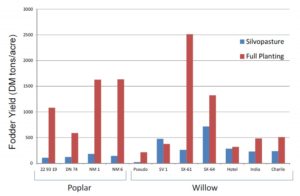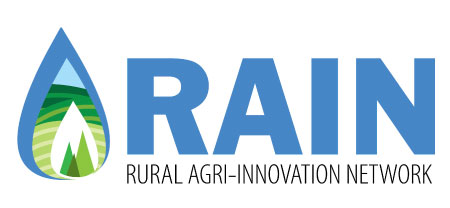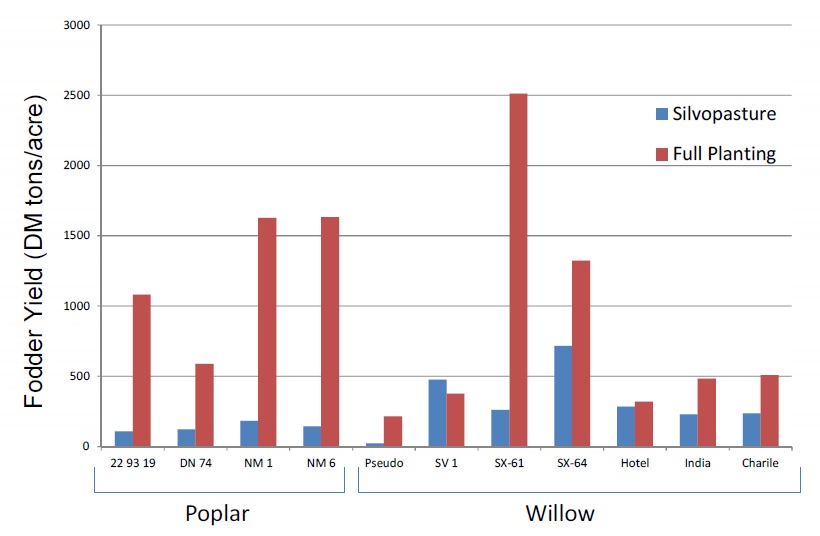This research note is part of a series detailing results from different facets of the trial. For more information, see:
Fodder Trees: 2015 Yield and Nutrient Analysis
2015 Sheep Production Report on Fodder Tree Diet
2015 Sheep Preferences of Fodder Trees
RAIN has partnered with the Ontario Sheep Marketing Agency to investigate whether fast-growing, coppiced trees can be a nutritionally and economically viable fodder source for sheep. This project is taking place over the 2015 and 2016 growing seasons near Sault Ste Marie.
Method
In 2007, a short rotation woody coppice plantation was established by the Canadian Forest Service to assess the potential of fast growing willow and poplar for bioenergy. A section of this plantation was fenced off and split into four 0.75 acre paddocks. Trees were cut to 4” and allowed to regrow to heights of 12-24” before sixty mature, dry ewes rotationally grazed the new re-growth. Outside the grazed area, three species of native trees (Speckled Alder, Trembling Aspen, and White Birch) were also coppiced for comparison with the domestic varieties. Samples of the new growth were taken to determine dry matter yields and nutrient content of the tree re-growth.
Results
Applicable arrangements and projected yields
Using the information gathered from the first year of this project, we can assess practical arrangements that can be used by sheep producers in a pasture setting. Two arrangements were selected; 1) Full Planting (FP) for windbreaks and fence lines, and 2) Silvopastural planting (SP).
A FP would have a similar density to that on the study site, but would be planted linearly rather than in a full block. This arrangement is appropriate for establishing windbreaks along roadsides or fence lines or in other windy areas on the farm. The full planting stem density with 0.6m (~2ft) spacing between trees creates a population density of 11,242 trees/acre. To use this system as a wind break, trees must be allowed to grow to their full height for the entire growing season and animals introduced prior to leaf fall. Projected yield under this system, using the most productive and preferred willow varieties could be in the range of 1000 – 2500 lbs DM/acre per year (Figure 1).
The second arrangement, SP, fits with typical rotational grazing systems used by pastured livestock farms. This system aims to keep plants in a vegetative state, which provides increased plant growth and nutritional value. A typical arrangement may include evenly spaced rows 30 – 50 ft. apart within the pasture. At 34 ft. spacing, this works out to 1,210 trees/acre and if grazed three times in the growing season could yield in the range of 250 – 750 lbs DM/acre per year (Figure 1).

Figure 1. Projected dry matter yield (tons/acre) for a full planting (FP) and silvopasture (SP) scenarios
Click on graph to enlarge
Economic consideration between systems
Whether your farm application is FP or SP, costs can be considerably different. FP for windbreaks provides additional value outside of fodder, but costs are much higher per unit area to establish. Site preparation and weed control costs will be similar for both FP and SP, but tree material and planting costs vary greatly for an acre. For the FP system, at an installation cost of $0.4/tree the total cost is for one acre is $4,497 where one acre of SP will cost $484. To take this and additional step further, we looked at cost per pound of dry matter. For the FP system with a yield of 1500 lbs DM/acre/yr over a five year period the cost is $0.6/lb of DM. For the SP system with a yield of 500 lbs DM/acre/year over a five year period costs $0.2/lb DM. Although the FP system offers a valuable dual purpose as windbreak and shelter, the cost per pound of DM over the first five years is triple. All forage production after five years is essentially free.
Economic analysis completed by Saul Fraleigh.
Thanks to our farmer co-operators Brent Attwell and Colleen Alloi for their assistance with this project.


Comments 3
Pingback: Rural Agri-Innovation Network (RAIN) - Fodder Trees: 2015 Yield and Nutrient Analysis | Rural Agri-Innovation Network (RAIN)
Pingback: Rural Agri-Innovation Network (RAIN) - 2015 Sheep Preferences of Fodder Trees | Rural Agri-Innovation Network (RAIN)
Pingback: Rural Agri-Innovation Network (RAIN) - 2015 Sheep Production Report on Fodder Tree Diet | Rural Agri-Innovation Network (RAIN)